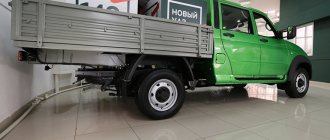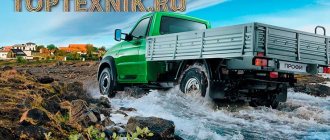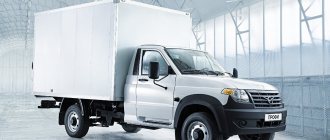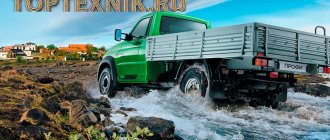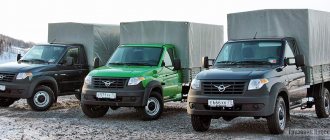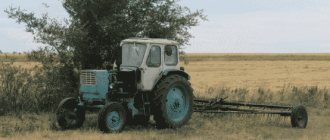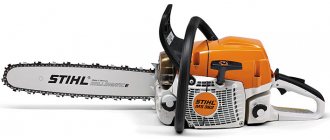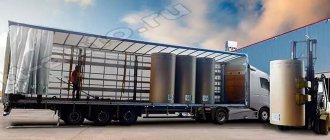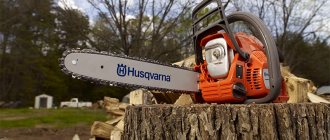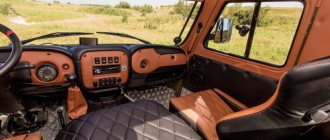UAZ Profi Manufactured goods van
Manufactured goods van UAZ Profi
Practicality, price, safety, comfort. The UAZ Profi manufactured goods van guarantees an excellent balance of qualities that are essential for freight transportation. The new version makes the light commercial vehicle increasingly versatile for carrying out daily business tasks without losing its best qualities.
The goal is to deliver furniture, household appliances or building materials safe and sound? UAZ Profi will do it. In the city or on the highway - it doesn’t matter. A manufactured goods van is the most practical modification for transporting goods that require protection from external influences. The product will remain safe in any weather: snow, rain, hurricane! Safe delivery, high level of safety and protection of cargo from unauthorized access is the key to a successful business.
At the same time, the manufactured goods van has all the best qualities of the model. UAZ Profi is reliable, comfortable and safe. It is difficult to overestimate its ability to solve a wide range of problems and, under any circumstances, deliver cargo to the door, no matter where it is. Rest assured that your business is in a reliable car.
Characteristics **
| Model | 236021-01 | 236022-01 | 236021-01 (GBO) | 236022-01 (GBO) |
| Drive unit | 4x2 | 4x4 | 4x2 | 4x4 |
| Passenger capacity, persons | 3 | 2 | 3 | 2 |
| Total weight, kg | 3500 | 3500 | 3500 | 3500 |
| Van weight, kg | 537 | |||
| Overall length, mm | 5990 | |||
| Overall height, mm | 1900 (for cabin), 2910 (for van) | |||
| Overall width, mm | 2545 | |||
| Wheelbase, mm | 3500 | |||
| Front wheel track, mm | 1600 | |||
| Rear wheel track, mm | 1600 | |||
| Turning radius, m | 6,1 | 6,9 | 6,1 | 6,9 |
| Front overhang, mm | 850 | |||
| Rear overhang, mm | 1590 | |||
| Approach angle/departure angle, degrees. | 33/21 | |||
| Minimum ground clearance, mm | 210 | |||
| Cabin | triple | double |
| Organizer under the passenger seat | Yes | No |
| Box between the front seats | No | Yes |
| Number of cup holders | 1 | 2 |
| Cup holder location | on the rear wall of the cabin | in the floor tunnel |
| Overall dimensions (external), LxWxH, mm | 3165x2195x2010 |
| Internal dimensions, LxWxH, mm | 3035x2095x1845 |
| Van area, m2 | 6,35 |
| Capacity in pallets, pcs. | 5 |
| Van volume, m3 | 11,73 |
| Loading height, mm | 998 |
| Vehicle model | 236021-01 | 236022-01 | 236021-01 (GBO) | 236022-01 (GBO) |
| Engine model | ZMZ - 409052 Four-stroke Petrol | ZMZ - 409052 Four-stroke Gasoline | ||
| Number and arrangement of cylinders | 4, in-line | |||
| Working volume, cm³ | 2693 | |||
| Cylinder diameter and piston stroke, mm | 95.5 x 94 | |||
| Maximum power, kW (hp) at rpm | 110 (149,6)/ 5000±100 | 105.15 (143)/ 5000±100 (including PBA) | ||
| Maximum torque, Nm at rpm | 235,4/ 2650±100 | 227.5/ 2650±100 (including PBA) | ||
| Fuel used | Gasoline 92/95 | Gasoline AI-92/95 propane-butane for automobiles (PBA) | ||
| Transmission | 5-speed manual | |||
| Transfer case | No | Mechanical, two-stage, with direct and reduction gear. Control with one lever. | No | Mechanical, two-stage, with direct and reduction gear. Control with one lever. |
| type of drive | 4×2 with rear wheel drive | 4×4 with plug-in front-wheel drive | 4×2 with rear wheel drive | 4×4 with plug-in front-wheel drive |
| Downshift ratio | — | 1.940 | — | 1.940 |
| Front suspension | dependent, spring, with anti-roll bar |
| Rear suspension | dependent, leaf spring, with anti-roll bar |
| Steering gear | Steering gear with power steering |
| Brake system | Hydraulic with ABS, with vacuum booster |
| Service brake type (front/rear) | With ventilated disc mechanisms / with drum mechanisms |
| Wheel disks | 6.5Jх16Н2 |
| Tires, load-bearing capacity index, speed category designation | 225/75R16C 121 (1450 kg) N (140 km/h) |
| Vehicle model | 236021 | 236022 | 236021 (GBO) | 236022 (GBO) |
| Fuel tank volume | 68 (gasoline) | 93 (PBA) | ||
| Fuel consumption when driving at a constant speed of 80 km/h, l (gasoline/gas): | 11,6 | 11,6 / 13,8 | ||
| Maximum speed, km/h | 130 | 125 | ||
What is the price?
It is clear that the UAZ Profi Polutorka is not an ideal car, despite all the innovations. But the Ulyanovsk lorry is cheaper than the other lorry - the Nizhny Novgorod one. The price remained the lowest in the segment: from 1,075,000 for the simplest version.
An improved driver's seat has appeared on the list of options - from the top-end Patriot configuration. Very comfortable, with adjustments for height and reach of the lumbar support. It can only be ordered in a package with air conditioning, cruise, heated windshield and seats - for 65 thousand rubles. It’s a pity that it’s only all together, but the price for such a set is reasonable. An armrest between the seats was also installed during the modernization. It is clear that the car was conceived without him. It put an end to the use of the bottle holder on the rear wall, interferes with the settings of the driver's seat and is short so that it is convenient to operate the gearbox lever with the hand lying on it.
An improved driver's seat has appeared on the list of options - from the top-end Patriot configuration. Very comfortable, with adjustments for height and reach of the lumbar support. It can only be ordered in a package with air conditioning, cruise, heated windshield and seats - for 65 thousand rubles. It’s a pity that it’s only all together, but the price for such a set is reasonable. An armrest between the seats was also installed during the modernization. It is clear that the car was conceived without him. It put an end to the use of the bottle holder on the rear wall, interferes with the settings of the driver's seat and is short so that it is convenient to operate the gearbox lever with the hand lying on it.
The long-wheelbase Polutka starts at 1,125,000 rubles. GAZelle Business is about 150 thousand more expensive.
NEW HARDWAREFront suspension now on four trailing arms, the shock absorbers were moved inside the springs. The compression stroke increased from 73 to 85–90 mm. In the steering a damper appeared, the rods became straight and more rigid. |
Van design**
| Execution "Standard" | Execution "Optimum" | |
| General van design | Frame. Frame processed | Frameless |
| External dimensions: LxWxH, mm | 3165x2195x2010 | 3170x2130x2070 |
| Internal dimensions: LxWxH, mm | 3035x2095x1845 | 3030x2005x1936 |
| Van volume, m3 | 11,73 | 11,76 |
| Loading height, mm | 998 | 1008 |
| Exterior material of van walls and doors | clad metal | Galvanized steel sheet with polymer coating |
| Internal material of the walls and ceiling of the van | — | Plywood 4 mm |
| Van floor material | Transport plywood 18 mm | Waterproof Laminated Plywood with Mesh Cover |
| Door design | hinged doors with an opening angle of 270 degrees | |
| Accessories |
|
|
| Wrapping the van outside | Aluminum alloy corner | Galvanized semicircular corner with coating |
| Door seal | black color | Gray polymer, glued at the corners |
| Electrical equipment | Side lighting - LED lights at the front are white, at the rear are red. Additional stop signal located between the locking bars | |
| Van interior lighting | Lamp with switch | |
| Van equipment | Chips made of polymer material located at the bottom of the rear door portal | |
|
| |
| Van reflective elements | On the rear doors | No (not required) |
**The image of products in drawings and photographs may differ from their actual characteristics, including due to the scales used, the functionality of computer hardware and software, deviations of the natural color of the product from its reproduction and other circumstances. The information contained in product descriptions regarding prices, technical characteristics, dimensions is indicative, does not constitute the terms of a public offer and may differ from the prices and characteristics of products available for sale. For more detailed information, contact the manufacturer or its representative.
Auto legends of the USSR. Trucks. UAZ-452D, -3303 (20 photos)
Author: gubernattor
03 April 2014 21:20
Tags: USSR auto legend SUVs
8682
20
UAZ-452D is a Soviet representative of the UAZ-452 family of trucks, produced in 1966-1985. It has a two-seater cabin and a wooden body. It was developed to replace the corresponding models of previous families of trucks - UAZ-450D and UAZ-451D. Since 1985, the car has been called UAZ-3303. The UAZ-452 family on paper was born simultaneously with the 451 family, became its logical continuation and structurally had much more in common with rear-wheel drive cabovers than with all-wheel drive 450s. The new all-wheel drive family inherited from the 451 platform not only the layout, but also a number of updated units. If modifications of the UAZ-450 were equipped with an adapted Pobedov engine, then, starting with the 451 model, it became possible to equip Ulyanovsk cabovers with a lighter and more powerful engine from the 21st Volga, which also underwent a number of minor design changes. The power unit of the ZMZ-451 model differed from the GAZ-21 engine in the design of the rocker cover, oil pan, mounting brackets for the front engine support cushions, thermostat, water drain valve from the cylinder block and, as stated in the operation and repair manual, “some normalities” . Otherwise, it was the “21st” engine, well known to car enthusiasts in the country, with a displacement of 2445 cm3 and a power of 70 hp. Sometimes in technical documentation this engine was designated as “UAZ-451”, but this kind of confusion stopped in the fall of 1969, when the production of power units for UAZs of the “451” and “452” families was mastered by the Ulyanovsk Motor Plant, which a year earlier had been renamed from the Ulyanovsk Small Car Plant engines. From that moment on, the engines were designated UMZ-451. A more powerful engine required a more “flexible” gearbox - the three-speed gearbox used on the UAZ-450 did not allow rational use of the dynamic resources of the Volgov engine. Therefore, during the development of the “451” family, Ulyanovsk designers created a four-speed gearbox, which was also inherited by the second generation of cabover all-wheel drive vehicles. An interesting detail. The designers were so carried away by achieving optimal weight distribution along the axes that, when moving the engine back, they missed an important point: the fourth cylinder ended up under the rear wall of the cab in trucks and under the partition separating the cab from the transport compartment in vans and minibuses. Access to this fourth cylinder remains a signature headache for drivers and mechanics to this day. But, as intended, there is much more space in the cabin for the driver and passenger. The radiator, which moved back and down along with the engine, freed up space in the front part of the cabin, which ultimately made it possible to move the air intake of the cooling system to the lower part of the front panel, and install a heater under the dashboard. In addition, the gearbox and transfer case control levers were moved from the rear of the hood to the tunnel between the front seats. Of course, the main distinguishing feature of the “452” family should have been the transfer case and front drive axle. In relation to these units, Ulyanovsk designers showed prudence and foresight. Back at the turn of the fifties and sixties, when the architecture of a cargo-passenger jeep was just being laid to replace the GAZ-69, the future UAZ-469, it was decided to unify as much as possible the transmission parts of two branches of promising Ulyanovsk SUVs - multi-purpose cargo-passenger vehicles and cabovers. By the time the UAZ-452 family was created, drive axles unified with the UAZ-469B had already been developed (a version without wheel gears was used) and a two-stage transfer case. The chassis and body, compared to rear-wheel drive cabovers, have not undergone any changes on second-generation all-wheel drive models. It should be taken into account that shortly before the start of production of the 452s and 451s, they were modernized: they received reinforced springs (which made it possible to increase the load capacity of rear-wheel drive trucks to one ton) and clutch, which were automatically inherited by the new SUVs. The result was an extremely simple, reliable and maintainable car, perfectly suited for use on Russian “directions” that replace our roads. The only inherent disadvantages of the new model were “gluttony” and the inherent low passive safety of the cabover design. Designers E.V. worked on the “452” project. Varchenko, L.A. Startsev, M.P. Tsyganov and S.M. Tyurin. The first running models of cars of the new family began to be built in 1960. To begin with, the body of a UAZ-450 van was installed on the UAZ-451D chassis, and it was this hybrid that became a “stand” for assembling all-wheel drive units. At the end of the year, the first all-wheel drive running sample of a sanitary van with a “450A” body passed factory tests in Central Asia. In 1963, factory tests of prototypes of the entire family were completed - the UAZ-452 van, the UAZ-452D truck and the UAZ-452A ambulance. OGK began preparing the documentation necessary for production. Then, over the course of three years, the design was “finished”, the vehicles passed interdepartmental and state tests, and OGK designers created the first specialized modifications - UAZ-452AS (sanitary van for the North) and UAZ-452DP (export truck with right-hand drive) . In 1966, the plant mastered the mass production of three main models of the 452 family, which received an updated front exterior with a trapezoidal radiator grille (the prototypes had the exterior of the 450 family). In 1971, the cars received a modernized UMZ-451M engine, the power of which increased from 70 to 75 hp, and the service life increased from 120 thousand to 150 thousand km. mileage In 1976, the Ulyanovsk Motor Plant became part of the AvtoUAZ production association, and in the same year the UMZ-451M engine was awarded the State Quality Mark. Cars of the 452 family did not undergo significant external changes during their production - only in the second half of the 70s did larger mirrors begin to be installed, moving from the front panel of the body to the doors. In addition, at the end of the 70s (presumably in 1979), the UAZ-451 and UAZ-452 families received new lighting equipment that complied with the current UNECE rules - the front sidelights received an orange section, the FP-100 rear lights were replaced with original rectangular lights form FP-132, for which it was necessary to slightly change the stamps of the body panels at the rear of buses and vans, and for buses and vans, in addition, side turn signal indicators appeared immediately behind the front doors. In May 1966, the car was awarded the VDNKh gold medal.
0
See all photos in the gallery
0
×
0
0
Most of the trucks from Ulyanovsk rolled off the assembly line in khaki colors and drove along our roads in a variety of shades of green.
0
UAZ-452D in exhibition colors at VDNH in 1974.
0
0
0
The beginning of work on three-axle all-wheel drive vehicles dates back to the late 60s - early 70s of the twentieth century. The experimental UAZ-452DG received an original transfer case, introduced into the design due to the addition of a third drive axle. The new box provided permanent drive to the rear axle and the ability to synchronously connect the middle and front axles. Pushing forces and the perception of reaction torque in the rear suspension were transmitted through springs and two torsion bars.
0
Work on three-axle all-terrain vehicles was curtailed by the automobile plant due to a significant decrease in traction and speed characteristics and an increase in fuel consumption with a relatively low increase in cross-country ability. Surprisingly, the experimental UAZ-452DG, in a slightly modified form (pictured), survived until at least 1996 as an in-plant transport.
0
The UAZ-452P truck tractor was built on the basis of the all-wheel drive UAZ-452D (also non-serial at that time and still having the exterior of the 450 family) - instead of an onboard body, a bracket for a spare wheel and a subframe with a fifth-wheel coupling were mounted on the vehicle frame.
0
In total, at least three cars were built. Factory tests of vehicles with semi-trailers were carried out from January 15 to June 9, 1962. The operating time of each road train was about 4,000 kilometers. State tests of UAZ-452P tractors with semi-trailers were carried out in Moscow from July 20, 1962 to January 20, 1963. The cars were not put into mass production.
0
An experimental snowmobile with skis instead of front wheels and rubber-metal tracks at the rear.
0
UAZ-452DE with a set of airfield lighting equipment “Luch-4P”
0
PRTS "Granat-2" on the UAZ 452D chassis
0
Experienced UAZ 33034
0
0
Experienced UAZ 33031
0
Experimental model of an electric vehicle on the UAZ 452D chassis
0
Belaz 452 and Trekmaster - under these names they tried to sell the UAZ-452 in various modifications on Western markets in the 1970s - when oil is not very expensive, our homeland needs other sources of foreign exchange earnings. Not very many of these BelAZs were sold, but one of them even appeared in the relatively recent film “Charlie and the Chocolate Factory” as a police van.
0
Author's post
Related links:
- Auto legends of the USSR. Trucks. KrAZ-219, -257
- Auto legends of the USSR. Trucks. GAZ-51
- Auto legends of the USSR. Trucks. GAZ-53,-52
- "Black Thursday" of US strategic aviation
- Auto legends of the USSR. Trucks. ZIL-130
Tags: USSR auto legend SUVs
ANTI-FISH All about politics in the world
Do you like to remember how things were before? Join us, let's feel nostalgic together:
33 6 27
Liked
27 1
2
Partner news
Interior
Cabin interior: everything is done for the convenience of the driver and passengers
- Lightweight ergonomics of the driver's workplace: driver's seat with adjustments and lumbar support
- Comfortable single passenger seat (for 4x4 versions)
- Double passenger seat with armrest and organizer (for 4x2 versions)
- Pleasant to the touch steering wheel, adjustable for reach and tilt
- Intuitive instrument cluster
- Multifunction monochrome display of on-board computer
- Directly accessible controls (climate control, multifunction steering column switches)
- Electrically adjustable and heated rear view mirrors
- Electric windows
- Air conditioning and cooled glove box
Interior of modification with all-wheel drive
Little nothings of life
During the week I noticed four defects in the UAZ.
One small one:
the lamps in the taillights periodically turn on only after hitting the lampshade.
One medium:
the van is too close to the cabin and the awning cable is rubbing against the paint. There is no need to tell you what happens to unprotected UAZ metal.
But two are comical.
The prompt for timely gear changes in the instrument cluster persistently suggests changing to fifth, although the car is already moving in it. And the plastic exterior trim of the cabin has already faded to resemble “winter camouflage.”
The replacement of the suspension and wheels did not leave its mark on the track: the front one increased from 1600 to 1648 mm, the rear one decreased from 1600 to 1550 mm. The front axle has been moved forward by 30 mm: when looking at the wheel arch, you can see that the wheel is slightly closer to its front edge.
The replacement of the suspension and wheels did not leave its mark on the track: the front one increased from 1600 to 1648 mm, the rear one decreased from 1600 to 1550 mm. The front axle has been moved forward by 30 mm: when looking at the wheel arch, you can see that the wheel is slightly closer to its front edge.
| Handles tolerably, good seat, 150 liters of gas | Gasoline consumption, gearbox whine |
Nominee for the Grand Prix “Behind the Wheel”
Safety
Safety as standard.
- For the first time, a domestic truck is equipped with an airbag!
- ABS system (anti-lock braking system)
- EBD (Brake Force Distribution) System
- Seat belt height adjustment
- Special arrangement of units in the engine compartment - increased safety in a frontal collision"
- Hood arrangement psychological protection of the driver and passengers
Load capacity and chassis
The new UAZ Profi is a representative of the light commercial truck segment. Fully adapted for freight transportation in its category.
- Load capacity 1500 kg
- Gross weight up to 3500 kg
- Reinforced rear axle
- Parabolic rear springs
- Reinforced frame structure of the car. 100% adaptation to Russian operating conditions and the ability to install a wide range of add-ons
- Dependent spring suspension with anti-roll bar. Provides a smooth ride on any road surface
- High energy intensity of the suspension. Allows you to comfortably overcome any unevenness, while not being inferior in reliability to spring suspensions
- New design of steering knuckles. Used specifically for the new UAZ Pro to improve maneuverability and reduce the turning radius
Six tires
Previous single tires would flatten under high loads, even if they were inflated at higher pressures. The car stood more or less confidently in turns only when it was empty. Even a small load generated large rolls of the stern, and this caused the Pro to change its trajectory in turns.
The pros lack niches, shelves, cup holders and charging connectors. Among more modern classmates, their count exceeds ten.
The pros lack niches, shelves, cup holders and charging connectors. Among more modern classmates, their count exceeds ten.
There is no longer a standard media system on the front panel: it was poorly installed. A mid-size smartphone fits perfectly into the niche underneath it as a navigator: everything is visible, it doesn’t fall anywhere, and there’s no need for a holder.
There is no longer a standard media system on the front panel: it was poorly installed. A mid-size smartphone fits perfectly into the niche underneath it as a navigator: everything is visible, it doesn’t fall anywhere, and there’s no need for a holder.
I noticed the beauty of the dual-pitch rear tire already at the loading stage. The shape of the tires remains the same. And in turns the Polutorka behaves noticeably better. This applies to both loaded and empty states. You will have to pay for improved behavior when changing tires. Six smaller wheels are more expensive than four larger ones. The overpayment for the set, including tire fitting, will be approximately 3,000–6,000 rubles, depending on the tire model.
The modernized steering with a damper made the Polutorka's reactions more accurate. But here’s a real miracle: of the four Pros that I drove, only this one’s steering wheel remained straight after several hundred kilometers. All the previous ones either initially “crooked” or began to float away after 400–600 km. The modified suspension architecture also contributed to improved handling.
MODIFICATIONSUAZ Profi with a single cab and a short wheelbase can be ordered in a “lightweight” version - with a permissible gross weight of 2500 kg instead of 3500. This eliminates problems with driving around Moscow. Technically, the car does not change in any way. Let's see how many of these will sell. |
